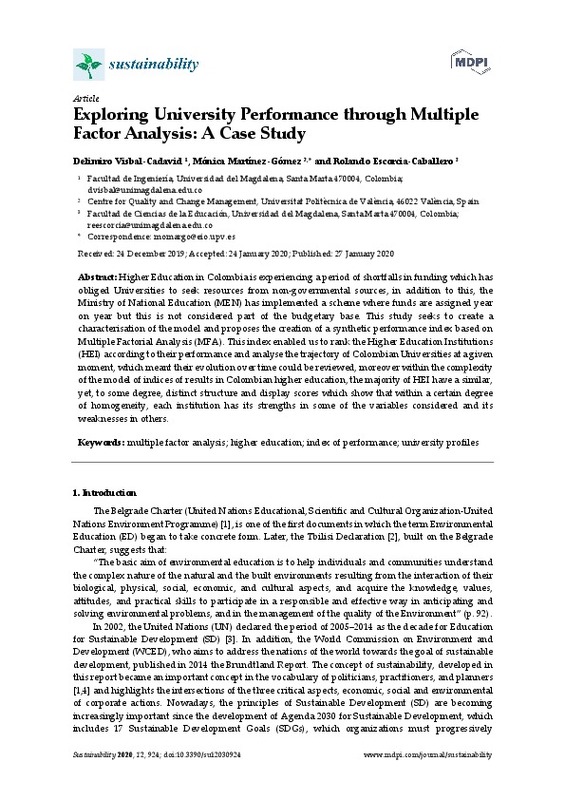Venkataraman, B. (2009). Education for Sustainable Development. Environment: Science and Policy for Sustainable Development, 51(2), 8-10. doi:10.3200/envt.51.2.08-10
Burton, I. (1987). Report on Reports: Our Common Future. Environment: Science and Policy for Sustainable Development, 29(5), 25-29. doi:10.1080/00139157.1987.9928891
Jickling, B., & Wals, A. E. J. (2008). Globalization and environmental education: looking beyond sustainable development. Journal of Curriculum Studies, 40(1), 1-21. doi:10.1080/00220270701684667
[+]
Venkataraman, B. (2009). Education for Sustainable Development. Environment: Science and Policy for Sustainable Development, 51(2), 8-10. doi:10.3200/envt.51.2.08-10
Burton, I. (1987). Report on Reports: Our Common Future. Environment: Science and Policy for Sustainable Development, 29(5), 25-29. doi:10.1080/00139157.1987.9928891
Jickling, B., & Wals, A. E. J. (2008). Globalization and environmental education: looking beyond sustainable development. Journal of Curriculum Studies, 40(1), 1-21. doi:10.1080/00220270701684667
LOUGHLAND, T., REID, A., WALKER, K., & PETOCZ, P. (2003). Factors Influencing Young People’s Conceptions of Environment. Environmental Education Research, 9(1), 3-19. doi:10.1080/13504620303471
Stevenson, R. B. (2006). Tensions and transitions in policy discourse: recontextualizing a decontextualized EE/ESD debate. Environmental Education Research, 12(3-4), 277-290. doi:10.1080/13504620600799026
Madeira, A. C., Carravilla, M. A., Oliveira, J. F., & Costa, C. A. V. (2011). A Methodology for Sustainability Evaluation and Reporting in Higher Education Institutions. Higher Education Policy, 24(4), 459-479. doi:10.1057/hep.2011.18
Nejati, M., & Nejati, M. (2013). Assessment of sustainable university factors from the perspective of university students. Journal of Cleaner Production, 48, 101-107. doi:10.1016/j.jclepro.2012.09.006
Yuan, X., & Zuo, J. (2013). A critical assessment of the Higher Education For Sustainable Development from students’ perspectives – a Chinese study. Journal of Cleaner Production, 48, 108-115. doi:10.1016/j.jclepro.2012.10.041
Ferrer-Balas, D., Lozano, R., Huisingh, D., Buckland, H., Ysern, P., & Zilahy, G. (2010). Going beyond the rhetoric: system-wide changes in universities for sustainable societies. Journal of Cleaner Production, 18(7), 607-610. doi:10.1016/j.jclepro.2009.12.009
Conferencia Mundial sobre la Educación Superior, Declaración mundial sobre la educación superior en el siglo XXIhttp://www.unesco.org/education/educprog/wche/declaration_spa.htm
Educación Superior en Iberoamérica Informe 2011https://cinda.cl/publicacion/educacion-superior-en-iberoamerica-informe-2011/
Educación Superior en Iberoamérica Informe 2016https://cinda.cl/publicacion/educacion-superior-en-iberoamerica-informe-2016/
Osorio Tangarife, M. P., Rodríguez Arias, N., & Salamanca Grosso, G. (2017). Técnicas de análisis multivariado, modelamiento factorial múltiple y PLS-PATH para estudio y clasificación de tipos de mieles venezolanas de los estados de Lara y Yaracuy. CIENCIA EN DESARROLLO, 8(1). doi:10.19053/01217488.v8.n1.2017.4732
Scholz, M. B. dos S., Kitzberger, C. S. G., Prudencio, S. H., & Silva, R. S. dos S. F. da. (2018). The typicity of coffees from different terroirs determined by groups of physico-chemical and sensory variables and multiple factor analysis. Food Research International, 114, 72-80. doi:10.1016/j.foodres.2018.07.058
Næs, T., Berget, I., Liland, K. H., Ares, G., & Varela, P. (2017). Estimating and interpreting more than two consensus components in projective mapping: INDSCAL vs. multiple factor analysis (MFA). Food Quality and Preference, 58, 45-60. doi:10.1016/j.foodqual.2016.11.012
Tomic, O., Berget, I., & Næs, T. (2015). A comparison of generalised procrustes analysis and multiple factor analysis for projective mapping data. Food Quality and Preference, 43, 34-46. doi:10.1016/j.foodqual.2015.02.004
Vtelleschi, M. S., & Chavasa, V. (2016). Análisis factorial múltiple para la caracterización de variedades de trigo pan en diferentes ambientes. FABICIB, 19, 113-120. doi:10.14409/fabicib.v19i0.5419
Zárraga, A., & Goitisolo, B. (2009). Simultaneous analysis and multiple factor analysis for contingency tables: Two methods for the joint study of contingency tables. Computational Statistics & Data Analysis, 53(8), 3171-3182. doi:10.1016/j.csda.2008.04.020
Pagès, J. (2005). Collection and analysis of perceived product inter-distances using multiple factor analysis: Application to the study of 10 white wines from the Loire Valley. Food Quality and Preference, 16(7), 642-649. doi:10.1016/j.foodqual.2005.01.006
Stanimirova, I., Walczak, B., & Massart, D. L. (2005). Multiple factor analysis in environmental chemistry. Analytica Chimica Acta, 545(1), 1-12. doi:10.1016/j.aca.2005.04.054
Escofier, B., & Pagès, J. (1994). Multiple factor analysis (AFMULT package). Computational Statistics & Data Analysis, 18(1), 121-140. doi:10.1016/0167-9473(94)90135-x
Robert, P., & Escoufier, Y. (1976). A Unifying Tool for Linear Multivariate Statistical Methods: The RV- Coefficient. Applied Statistics, 25(3), 257. doi:10.2307/2347233
Josse, J., & Holmes, S. (2016). Measuring multivariate association and beyond. Statistics Surveys, 10(0), 132-167. doi:10.1214/16-ss116
Garcı́a Lautre, I., & Abascal Fernández, E. (2004). A methodology for measuring latent variables based on multiple factor analysis. Computational Statistics & Data Analysis, 45(3), 505-517. doi:10.1016/s0167-9473(03)00037-9
Asbahi, A. A. M. H. A., Gang, F. Z., Iqbal, W., Abass, Q., Mohsin, M., & Iram, R. (2019). Novel approach of Principal Component Analysis method to assess the national energy performance via Energy Trilemma Index. Energy Reports, 5, 704-713. doi:10.1016/j.egyr.2019.06.009
Onat, N. C., Kucukvar, M., & Afshar, S. (2019). Eco-efficiency of electric vehicles in the United States: A life cycle assessment based principal component analysis. Journal of Cleaner Production, 212, 515-526. doi:10.1016/j.jclepro.2018.12.058
Tam, V. W. Y., Tam, C. M., Yiu, K. T. W., & Cheung, S. O. (2006). Critical factors for environmental performance assessment (EPA) in the Hong Kong construction industry. Construction Management and Economics, 24(11), 1113-1123. doi:10.1080/01446190600799620
[-]









